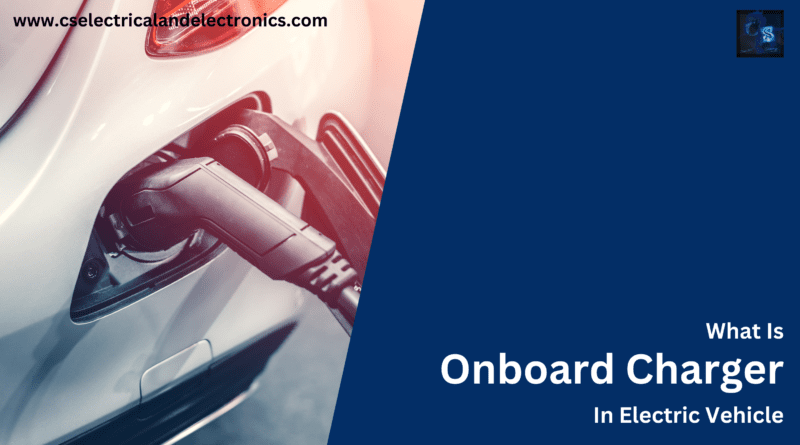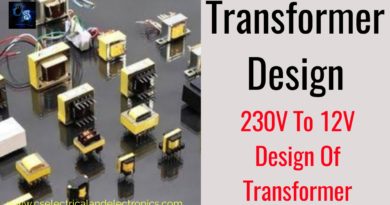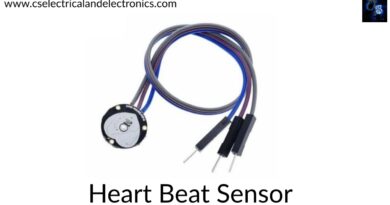What Is Onboard Charger, Purpose, Onboard Charger Working
Hello guys, welcome back to our blog. Here in this article, we will discuss what is onboard charger in an electric vehicle, the purpose of an onboard charger, its types, and its working.
If you have any electrical, electronics, and computer science doubts, then ask questions. You can also catch us on Instagram – CS Electrical & Electronics.
Also, read:
- What Is Single Line Diagram In Substation, Symbols Used
- Top 20 Reasons Why Gravel Or Stones Are Used In Substations
- Top 10 Electronic Starters Used In Electrical Motors, Latest Starters
What Is Onboard Charger In EV
An electric vehicle (EVonboard )’s charger is a power supply that is integrated into the vehicle and used to recharge the battery. Inverter chargers or integrated chargers are other names for it. The task of the onboard charger is to transform the AC power from a wall outlet or charging station into DC electricity that can be kept in the battery of the car.
Depending on the exact EV model and the size of its battery, onboard chargers are available in a range of sizes and capacities. Depending on the charging rate and the size of the battery, an EV battery might take anywhere from a few hours to several hours to fully charge.
Certain EVs can also fast charge, which entails using a powerful charging station to charge the battery quickly. These chargers can deliver a lot of power quickly, but they can also be more expensive and might put greater stress on the battery.
Overall, the onboard charger is an important part of an electric car since it makes it possible to charge the vehicle quickly and simply, which is necessary for everyday use and long-distance driving.
An electric vehicle (EVonboard )’s charger is a technological component used to recharge the battery. Inverter chargers or integrated chargers are other names for it. The onboard charger transforms AC electricity from a wall outlet or charging station into DC power that may be stored in the electric vehicle’s battery.
Rectifiers, inverters, and a power management system are a few of the crucial parts of the onboard charger. Rectifiers change AC power into DC power, and inverters change DC power back into AC so that the battery can be charged. The battery is charged appropriately and is not overcharged or undercharged thanks to the power management technology.
The individual EV model and the size of its battery determine the shape and capacity of the onboard charger. Depending on the charging rate and the size of the battery, onboard chargers can take anywhere from a few hours to several hours to fully charge an EV battery. A high-powered charging station, which can deliver a substantial amount of electricity in a short period of time, can be used to rapidly charge some EVs.
Overall, the onboard charger is an important part of an EV since it makes it possible to charge the vehicle quickly and simply, which is necessary for daily use and long-distance travel.
Working of Onboard Charger
An electric vehicle’s (EV) onboard charger transforms AC electricity from a wall outlet or charging station into DC power that may be stored in the EV’s battery. Here’s a quick explanation of how the integrated charger functions:
01. AC to DC Conversion:
Using a rectifier circuit, the onboard charger first transforms the AC power from the wall outlet or charging station into DC power. By switching the current flow from AC to DC, this operation is completed.
02. DC to AC Conversion:
The onboard charger employs an inverter circuit to convert the DC power back into AC power after converting the AC power to DC. This is required since the EV battery needs DC power but the wall socket or charging station only has AC power.
03. Power Regulation:
The battery’s power delivery is controlled by the onboard charger, which prevents overcharging or undercharging. A power management system is used to accomplish this, which continuously monitors the charging process and modifies the charging rate as necessary.
04. Charging Completion:
To avoid overcharging, the onboard charger automatically stops charging after the EV’s battery is fully charged. A smartphone app or other device can be used to remotely control the charging process, enabling the user to start or stop it as needed.
In general, an electric vehicle’s onboard charger is a crucial part since it enables the EV to be charged fast and effectively, which is necessary for daily use and long-distance travel.
Here are some additional details about onboard chargers:
One can distinguish between single-phase and three-phase onboard chargers. While three-phase chargers are used for fast charging at public charging stations, single-phase chargers are utilized for charging at home or in smaller charging stations. Compared to single-phase chargers, three-phase chargers are able to charge an EV battery more quickly.
The maximum charging capacity of onboard chargers is commonly indicated in kilowatts (kW). The size of the charger and the EV’s electrical system define the charger’s maximum charging capability. The power supply from the wall outlet or charging station, the kind of onboard charger, and the size of the EV battery can all affect the charging rate.
A smartphone app or other device can be used to remotely control and monitor onboard chargers. This enables the user to control the charging process by starting, stopping, and monitoring it as needed.
Certain onboard chargers can discharge electricity from the EV’s battery back into the grid because they are made to be bi-directional. In the event of a power outage or an emergency, this enables the EV to be used as a source of power for the house or other electrical devices.
Although not the only one, the onboard charger is a crucial part of the EV’s charging system. The battery management system, charging connection, and charging port are additional components. The battery management system monitors the battery’s state of charge and temperature during the charging process to ensure safety and efficiency. The charging cable and port connect the EV to the charging station or wall outlet.
Several charging rates, usually indicated in kilowatts, can be used by onboard chargers (kW). The power supply from the wall outlet or charging station, the kind of onboard charger, and the size of the EV battery can all affect the charging rate.
An EV’s charging time is influenced by a number of variables, including the battery’s size, charging rate, and level of charge. As an illustration, a larger battery will require more time to charge than a smaller battery, and a higher charging rate will result in a quicker charge. According to these variables, a full charge might often take a few hours to several hours.
Depending on the EV’s electrical system, onboard chargers can be made to function with various types of charging stations or wall outlets. For instance, some onboard chargers are made to function with Level 1 (120 volts) or Level 2 (240 volts) charging in North America, while others are made to function with Type 2 (230 volts) charging in Europe.
Depending on the charger’s size, capacity, and features, onboard charger prices can change. Onboard chargers are frequently a part of the cost of buying an EV, although they can also be added on as an aftermarket improvement.
Onboard chargers are made to be dependable and long-lasting, with little need for maintenance. However, if they are used regularly or in challenging environments, they might occasionally need software upgrades or repairs.
Ultimately, the onboard charger is a crucial part of an EV’s charging system because it makes it simple and practical to charge the car. Onboard chargers are anticipated to become increasingly more complex and advanced as the demand for EVs rises, delivering quicker charging periods, higher charging rates, and novel capabilities like bi-directional charging.
This was about “What Is Onboard Charger In EV“. I hope this article may help you all a lot. Thank you for reading.
Also, read:
- 10 Tips To Maintain Battery For Long Life, Battery Maintainance
- 10 Tips To Save Electricity Bills, Save Money By Saving Electricity
- 100 (AI) Artificial Intelligence Applications In The Automotive Industry
- 100 + Electrical Engineering Projects For Students, Engineers
- 1000+ Control System Quiz, Top MCQ On Control System
- 1000+ Electrical Machines Quiz, Top MCQs On Electrical Machines
- 1000+ MATLAB Simulink Projects For MTech, Engineering Students
- 50 Tips To Save Electricity At Home, Shop, Industry, Office
Author Profile
- Chetu
- Interest's ~ Engineering | Entrepreneurship | Politics | History | Travelling | Content Writing | Technology | Cooking
Latest entries
 All PostsApril 19, 2024What Is Vector CANoe Tool, Why It Is Used In The Automotive Industry
All PostsApril 19, 2024What Is Vector CANoe Tool, Why It Is Used In The Automotive Industry All PostsApril 13, 2024What Is TCM, Transmission Control Module, Working, Purpose,
All PostsApril 13, 2024What Is TCM, Transmission Control Module, Working, Purpose, All PostsApril 12, 2024Top 100 HiL hardware in loop Interview Questions With Answers For Engineers
All PostsApril 12, 2024Top 100 HiL hardware in loop Interview Questions With Answers For Engineers All PostsMarch 22, 2024Driver Monitoring Systems In Vehicles, Working, Driver Sleepy Alert
All PostsMarch 22, 2024Driver Monitoring Systems In Vehicles, Working, Driver Sleepy Alert








